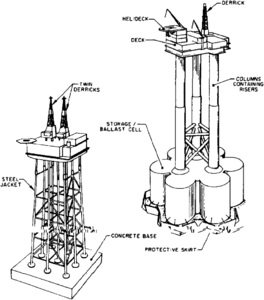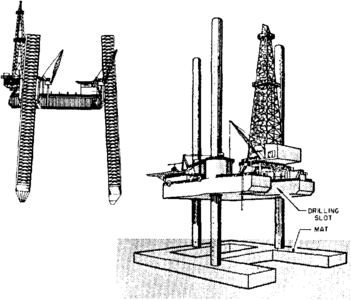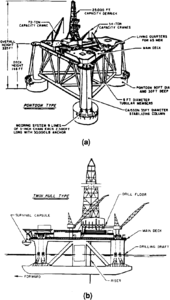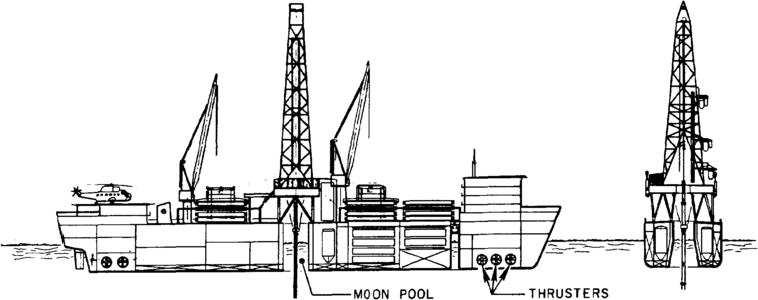Offshore rigs
| Development Geology Reference Manual | |

| |
| Series | Methods in Exploration |
|---|---|
| Part | Wellsite methods |
| Chapter | Offshore rigs |
| Author | Byram Reed |
| Link | Web page |
| Store | AAPG Store |
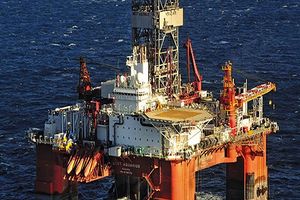
An offshore rig is a large structure on or in water with facilities to drill wells, to extract and process oil and natural gas, and to temporarily store product until it can be brought to shore for refining and marketing. In many cases, the platform contains facilities to house the workforce as well.
Offshore rigs are similar to land rigs but with several additional features to adapt them to the marine environment. Those features include
- Heliport
- Living quarters
- Cranes
- Risers
The heliport, also known as the helipad, is a large deck area that is placed high and to the side of offshore rigs. It is an important feature since helicopters are often the primary means of transportation. The living quarters usually comprise bedrooms, a dining hall, a recreation room, office space, and an infirmary. Escape boats are usually located near the living quarters.
Cranes are used to move equipment and material from work boats onto the rig and to shift the loads around on the rig. Most rigs have more than one crane to ensure that all areas are accessible. A riser is used to extend the wellhead from the mudline to the surface. On platforms and jackup rigs, the blowout preventers (BOPs) are mounted above sea level. On floaters, the BOPs are mounted on the seafloor.
Types of offshore rigs
Figure 1 Fixed production platforms. From Whittaker.[1]
Figure 2 Jackup rigs.[1]
Figure 3 Semisubmersible rigs, (a) Pontoon type semisubmersible. (b) Twin hull semisubmersible. From Whittaker.[1]
Figure 4 Dynamic positioning drill ship. From Whittaker.[1]
The various types of offshore rigs include barges, submersibles, platforms, jackups, and floaters (the latter of which include semisubmersibles and drill ships).
Barges
A barge rig is designed to work in shallow water (less than length::20 ft deep). The rig is floated to the drillsite, and the lower hull is sunk to rest on the sea bottom. The large surface area of the lower hull keeps the rig from sinking into the soft mud and provides a stable drilling platform.
Submersibles
A submersible rig is a barge that is designed to work in deeper water (to length::50 ft deep). It has extensions that allow it to raise its upper hull above the water level.
Platforms
Platforms use a jacket (a steel tubular framework anchored to the ocean bottom) to support the surface production equipment, living quarters, and drilling rig (Figure 1). Multiple directional wells are drilled from the platform by using a rig with a movable substructure. The rig is positioned over preset wellheads by jacking across on skid beams. After all the wells are drilled, the rig and quarters are removed from the platform. Smaller platforms use a jackup rig to drill the wells.
Jackups
Jackups are similar to platforms except that the support legs are not permanently attached to the seafloor (Figure 2). The weight of the rig is sufficient to keep it on location. The rig's legs can be jacked down to drill and jacked up to move to a new location. When under tow, a flotation hull buoys the jackup. The derrick is cantilevered over the rear to fit over preset risers if necessary.
Floaters
Offshore rigs that are not attached to or resting on the ocean bottom are called floaters. These rigs can drill in water depths deeper than jackups or platforms can. They have several special features to facilitate this:
- They are held on location by anchors or dynamic positioning.
- The drill string and riser are isolated from wave motion by motion compensators.
- The wellheads and BOPs are on the ocean bottom and are connected to the rig by a riser to allow circulation of drilling mud.
There are two categories of floaters: semisubmersibles and drill ships.
Semisubmersibles
Semisubmersibles (also called semis) are usually anchored in place (Figure 3). Although a few semis are self-propelled, most require towing. Because floaters are subject to wave motion, their drilling apparatus is located in the center where wave motion is minimal. Semis are flooded to a drilling draft where the lower pontoons are below the active wave base, thereby stabilizing the motion.
Drill ships
The drilling apparatus on a drill ship is mounted in the center of the ship over a moon pool, which is a reinforced hole in the bottom of the ship through which the drill string is raised and lowered (Figure 4). The ship can be turned into the oncoming wind or currents for better stability, and it can operate in water too deep for anchors.
